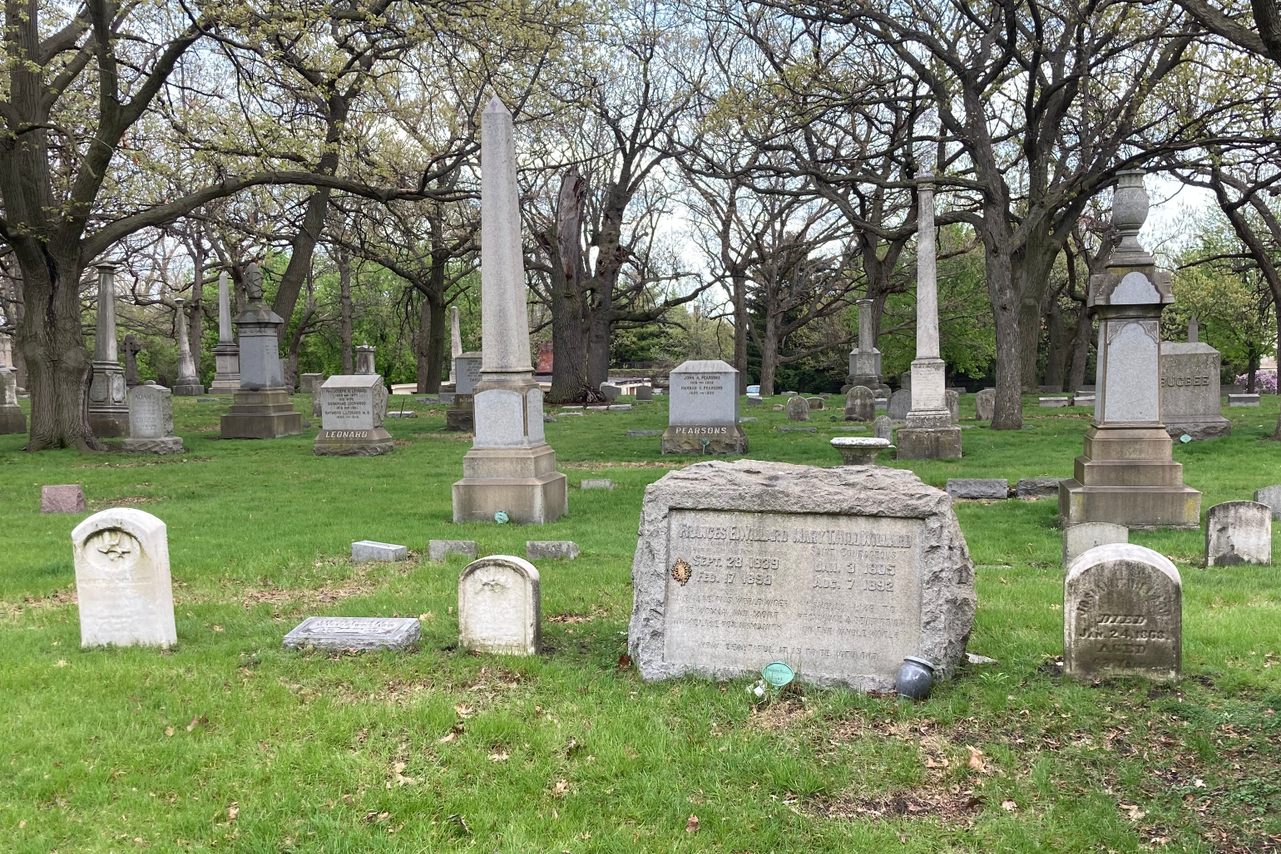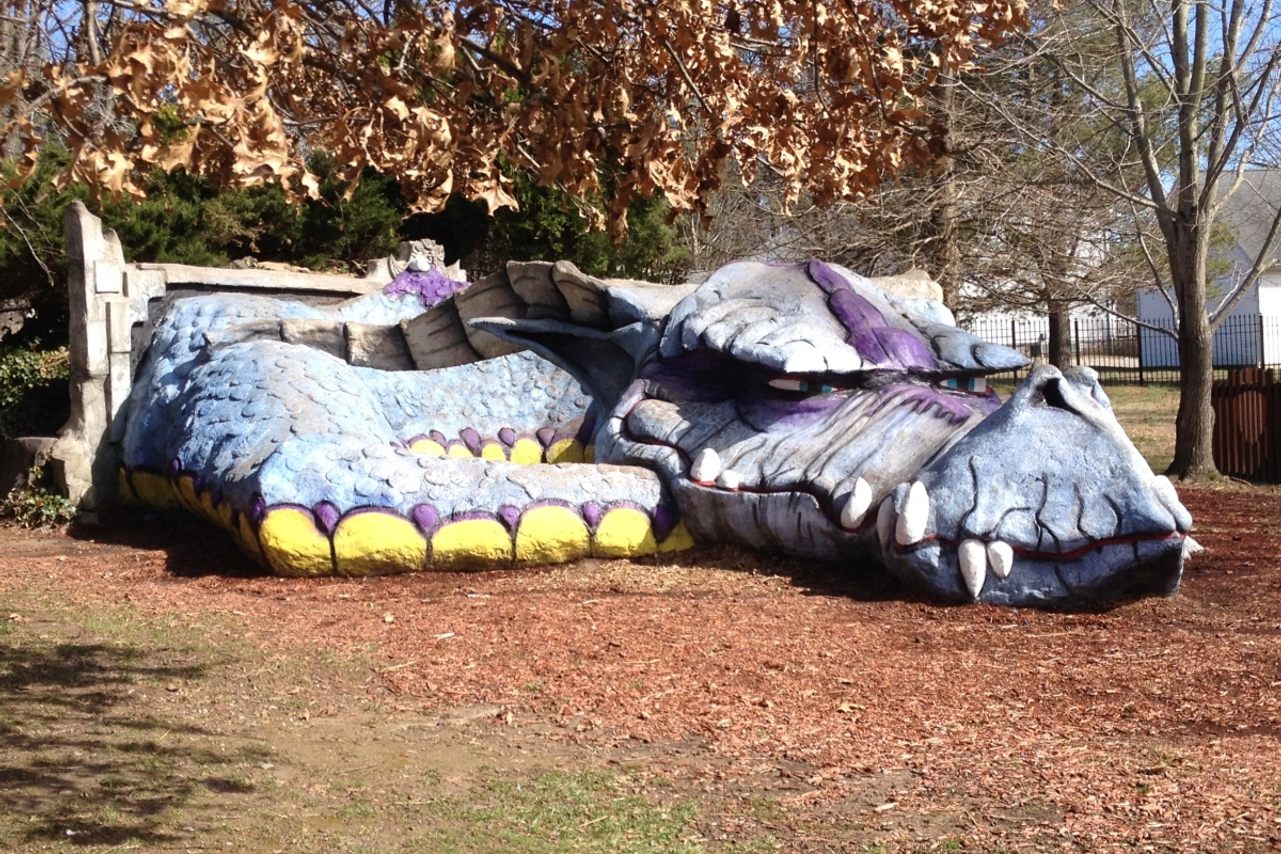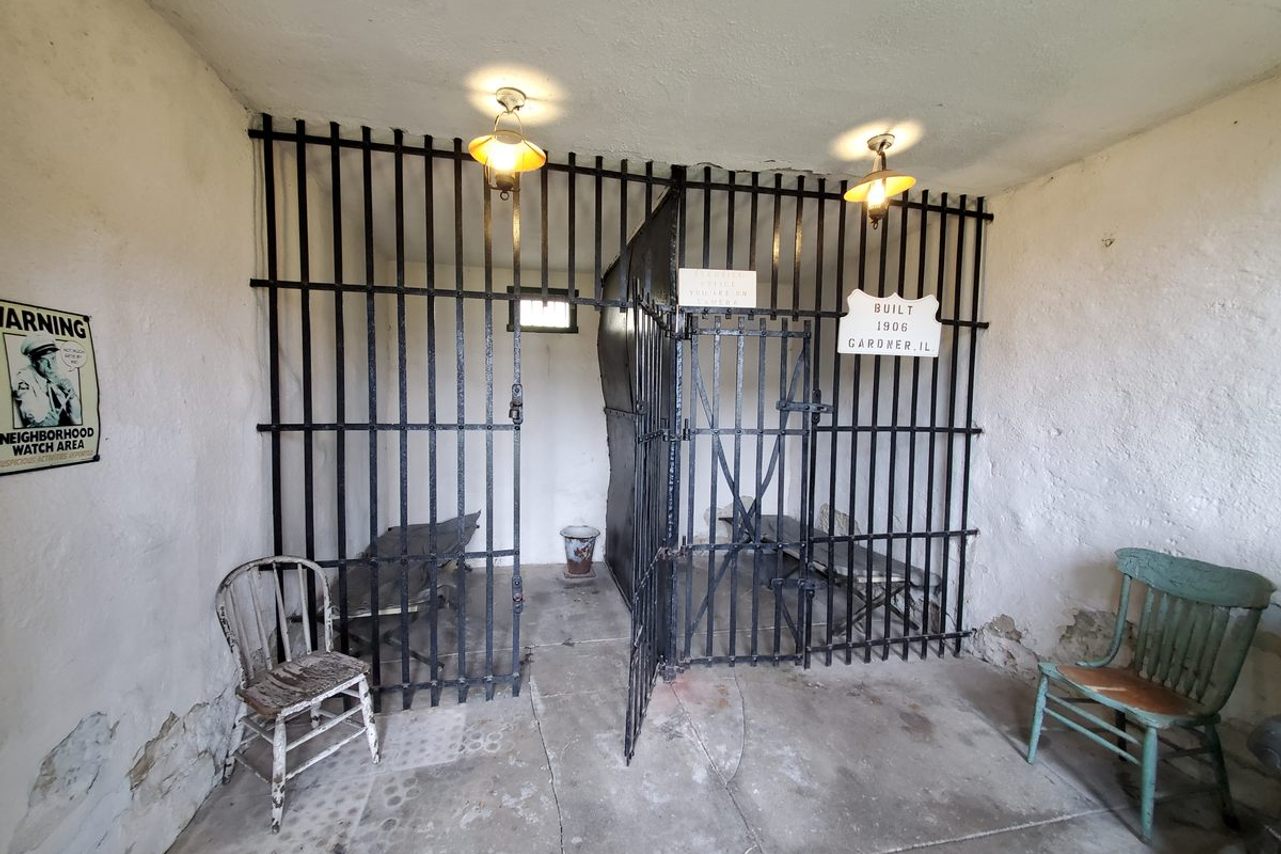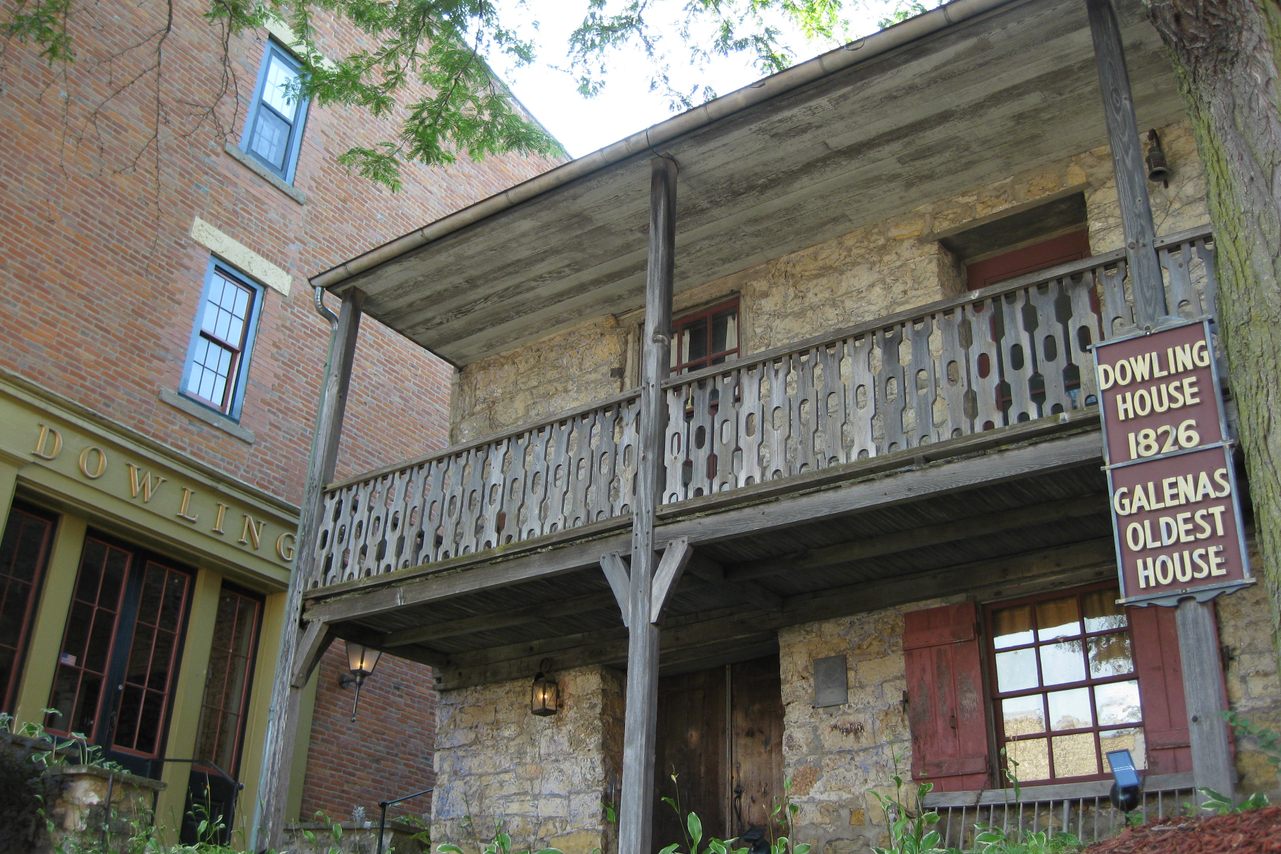
1. Graceland Cemetery
No trip to Chicago’s Graceland Cemetery is complete without a stop to look into the eyes of “Eternal Silence” to see your own death.
Among the historic cemetery’s most unsettling and legend-shrouded memorials, “Eternal Silence” is a daunting, 10-foot hooded figure commemorating the family of Dexter Graves, one of Chicago's first settlers.
Set against a stark black, granite base, the heavily oxidized original bronze has evolved into a faded, almost glowing, patina. The sculpture was created in 1909 by Illinois-born artist Lorado Taft, who—against all odds—seems to have survived the experience.
But there’s much more to see at Graceland than your own death. Check out the elaborate graves of city figures such as George Pullman, the inventor of the railway sleeper car, and Cyrus McCormick, who revolutionized farming with his mechanical reaper (not to be confused with the grim reaper).
And then there’s the glass-encased Inez Clarke Monument, commissioned by Clarke’s parents when she died at just seven years old. Since the 1980s, security guards and tour bus drivers have reported the statue’s inexplicable disappearance during the night … and reappearance the next morning.
Whether you’re seeking serenity, mystery, or a mélange of the two, Graceland Cemetery is the place for you.
4001 N. Clark Street, Chicago, Illinois 60613

2. Rosehill Cemetery
Like many storied cemeteries, Rosehill boasts its fair share of reports of disembodied voices. However, it might be the only Illinois cemetery with a clown. Back in 2015, passersby reported seeing a creepy clown scaling the locked gate and waving back at them (either eerily or enthusiastically—depends how you feel about clowns).
The clown may or may not have been on its way to entertain the ghosts whose human counterparts died in 1903 when Chicago’s Iroquois Theatre went up in flames. Nearly a third of the 1,700 people packed into the brand-new cinema were trampled to death as they tried to escape.
Coupled with its compelling stories, Rosehill is also a beautifully serene spot where you’ll find scores of Victorian-era sculptures, towering oaks, and draped urns.
Rosehill also has its own Civil War Museum, due to it being the burial site of hundreds of 8th Regiment, Illinois Cavalry Union soldiers, the first men to fire shots at Gettysburg. And in case you’re just here for the celebrity sightings, you’ll also find major power players like Richard Sears, Oscar Mayer, and department store magnate John D. Shedd.
Bonus fact: The name Rosehill is the result of an erroneous transcription of “Roe’s Hill,” after a local farmer.
5800 N Ravenswood Ave, Chicago, IL 60660

3. Raven’s Grin Inn
In the nearly 40 years since they opened the Raven’s Grin Inn, owners Jim and Jessica Warfield have heard story after story of visitors hearing and seeing the unexplained. Want to check it out for yourself?
Built in the 1860s in Mount Carroll, Illinois, the structure first served as an inn and tavern. In 1987, the Warfields bought the property with the idea of opening a haunted house.
Wanting to differentiate Raven’s Grin from the usual blood-and-gore-style fare, Jim decided to create a “haunted fun house,” packed with mazes, hidden passages, and eerie elements of performance art, along with the essentials (jump scares).
Once inside, a certain slide delivers you into the wine cellar (part of what we assume makes this a fun house). If you see a woman in the corner, don’t worry—she’s been appearing and disappearing in that spot for years. She may or may not be a holdover from the 1920s, when, according to the owners, the room was used as a speakeasy.
Tours are year round, by reservation only. Visit Facebook for tour information.
411 N Carroll St, Mt Carroll, IL 61053

4. Cahokia Mounds State Historic Site
Ten miles northeast of St. Louis once thrived what researchers believe to be the most sophisticated prehistoric Native American civilization north of Mexico. At its peak, the city of Cahokia was larger than London, but by 1400, the site was practically deserted. Why that is, no one fully knows, but among the archaeological remains left behind were a series of sacrificial burials.
Cahokia Mounds, in Collinsville, Illinois, is a 2,200-acre UNESCO World Heritage Site. Occupied from 700 to 1400, the city grew to roughly 4,000 acres, stretching across multiple satellite villages.
Theories for Cahokia’s demise range from epic floods to outside invasions. While some scientists believe the tribe was forced out by severe drought, more recent carbon-dating provides contradictory insights.
Monks Mound, the focal point of the central expanse, rises 100 feet, earning the coveted yearbook superlative: largest prehistoric earthen mound in the Americas. However, it’s Mound 72 that holds one of Cahokia’s strangest mysteries.
Mound 72 contained the burial site of both the city’s elite inhabitants as well as the graves of—potentially—sacrificial victims. On one platform, the bodies of four men, each missing their hands and heads, were discovered. In an adjacent pit, excavators discovered a trench holding the bodies of over 50 women, ranging from ages 15 to 30.
The story behind these deaths, and the abandonment of Cahokia? It’s possible we’ll never know.
30 Ramey Street, Collinsville, Illinois 62234

5. Lincoln’s Tomb
One of the most iconic and celebrated Presidents in U.S. history is entombed in Springfield, Illinois.
But despite best efforts to lay Abraham Lincoln to eternal rest, his tomb has been shrouded in drama since day one.
Two days after President Lincoln’s assassination on April 15, 1865, his widow, Mary Todd Lincoln, approved of his burial in Springfield. But Mary Todd was left off the actual burial committee, which decided (without her consent) to entomb her late husband in the city’s bustling downtown.
Mary Todd stepped in, urging that the tomb, per the President’s wishes, be relocated someplace quieter. The compromise: Oak Ridge Cemetery, set in a rural area north of town.
The drama didn’t stop at the receiving vault. Due to attempted theft and major reconstruction, Lincoln’s remains were uprooted and moved many times over the years. In 1874, a 117-foot obelisk was erected in Lincoln’s honor, complete with a bronze bust at the base of the memorial, whose nose has been steadily worn down over time. Two years later, Secret Service agents—hiding within the monument grounds—staved off a band of thieves angling to hold Lincoln’s body for ransom. Following the attempt, the powers that be proceeded to surreptitiously circulate Lincoln’s remains between various un-obelisked locations. When this grew tedious (by 1880), a group of local men formed the Lincoln Guard of Honor, dedicated to (among other things) proper protection of the President’s body.
But peace, for Lincoln, was not to be had. Between 1887 and 1889, his body was moved at least four more times, from a vault to a sarcophagus to a crypt. Finally, in 1901, his coffin was placed in a concrete and steel chamber, permanently safe from prying eyes—and hands.
Given that Lincoln was never given a proper chance to rest, it should come as no surprise that onlookers have reported sounds of laughter, weeping, whispering, and foot-tapping coming from his tomb.
1500 Monument Avenue, Springfield, Illinois 62702

6. Boo Castle Park
To commemorate a life, some people erect obelisks. Others open a free-to-the-public, Dungeons & Dragons-themed fantasy park.
Seven years after losing his son Jeremy to a car accident in 1993 in Carbondale, Illinois, Barrett Rochman purchased a nearby two-acre park and brought on friends and family members to design new features. Many of the structures, which include a wooden castle and intricate multi-level maze, were modeled after elements of the classic fantasy game, Dungeons & Dragons, one of Boo’s favorites. In fact, nine of the original sculptures were created by a local student and were based on figures Boo himself had painted.
After five years of preparation, Jeremy “Boo” Rochman Memorial Park, popularly known as Boo Castle Park, opened to the public in 2005.
Boo Castle Park is now home to an entire fantasy universe of dragons, wizards, trolls, unicorns, gargoyles, and knights. Jeremy’s memory lives on in the magical world created by his family and friends.
The park is open daily from 9 a.m. to dusk. Admission is free.
30 Homewood, Drive Carbondale, Illinois 62902

7. Old Joliet Prison
Ever since 2017, when the city of Joliet renovated its prison and opened it up to visitors, people from all over the world have come to tour its grounds. It’s particularly a destination for TV fanatics, having been featured in hit films and shows including “The Blues Brothers,” “Prison Break,” and “Empire.”
But before “Empire,” there was Dorothea Dix, a notable prison and asylum reformer. Dix petitioned for a replacement of the area’s first penitentiary, catalyzing the opening of Joliet Prison in 1858. At the time, the prison housed just 53 inmates within its compact structure.
However, 20 years later, the prison was packed with over 2,000 inmates, prompting yet another call for a safer, more sanitary prison. When a new facility opened, Old Joliet was abandoned, sitting vacant and derelict for decades, right up until the city stepped back in.
You can take a guided “Prison After Dark” tour on select evenings and learn the dark side of the prison’s past, or opt for a “Flashlight Tour.”
1125 Collins Street, Joliet, Illinois 60432

8. Two-Cell Jail
Along historic U.S. Route 66, in the tiny town of Gardner, Illinois, there’s a tiny jail built for two.
Constructed in 1906, the one-room, two-cell clink served as more of a holding place—an elevated time-out corner—for the town’s more unruly citizens until the 1950s. It wasn’t exactly known for housing hardened criminals, and provided the standard amenities: hard floor, rickety cot, and personal bucket.
Despite its current population of under 1,500, Gardner now has an additional jail, outfitted for more than two transgressors. However, the two-cell jail gives visitors a glimpse of corrections of days past.
Also on the property is the Christiansen Memorial, honoring Rev. Christian Christiansen, who once called Gardner home. During World War II, the Norway native delivered vital information to the Allies in order to destroy the Nazi campaign to build atomic bombs
400 E. Mazon Street, Gardner, Illinois 60424

9. Dorothy’s Grave
Only five months old when she died, Dorothy Gage was the niece of L. Frank Baum, author of The Wonderful Wizard of Oz. It is said that Baum named his now beloved main character, Dorothy Gale, to honor the little girl’s memory.
Dorothy was buried at Evergreen Memorial Cemetery in Bloomington, Illinois, her grave marked with nothing but a small headstone.
A historian named Sally Roesch Wagner was researching Baum’s mother-in-law, Matilda Gage, a suffragette who worked with Susan B. Anthony, discovered Dorothy’s faded gravestone, and word spread.
When actor Mickey Carroll, who played a Munchkin in the 1939 film, The Wizard of Oz, learned about Dorothy Gage and her weather-worn headstone, he sprung into action. An Illinoisan and a designer of monuments, Carroll decided to pay proper tribute to the character’s namesake and created a new design that would bring her legacy back to life. In 1997, the cemetery held a ceremony to unveil the new marker.
Decades later, cemetery leadership decided that an old oak near Dorothy’s grave required removal, and in 2017, they commissioned Bill Baker, a notable chainsaw carver, to craft the trunk into another memorial.
For over 30 hours, Baker used four different chainsaws to chisel his way through the tree, revealing a stunning homage to Baum’s young heroine, her little dog, Toto, and the Yellow Brick Road.
302 E. Miller Street, Bloomington, Illinois 61701

10. The Dowling House
Paint-peeled walls, 19th-century furnishings, and possibly, lead-poisoned ghosts—these are all things you might find at the 1826 Dowling House in Galena, Illinois.
Located about 160 miles west of Chicago, the bucolic town of Galena — meaning “sulfide of lead” in Latin — was once home to the lead-trade magnate John Dowling. Dowling’s home is now the oldest in Galena, and very likely the oldest structure in the entire state.
Wooed by the town’s lead rush, the prospector first arrived in 1826 with son Nicholas in tow (still 20 years before the famed California gold rush). Originally mined by the native Sac and Fox peoples, the area was formally established by Congress as the “Upper Mississippi Lead Mine District” in the early 1800s, and by 1826, Galena had been formally established. By 1845, the district was producing 85 percent of the country’s lead.
The Dowling House was a dual-use residence. The downstairs served as a trading post, the upstairs as living quarters. The house was eventually abandoned, but then scooped back up by the city in the 1960s and renovated into a museum.
Several outfits, such as Haunted Galena Tour Company, offer tours. Walk along from the Dowling House to other spooky, historic structures in town as you take in the darker stories, famous ghosts, and legends of this one-time boom town.
220 Diagonal Street, Galena, Illinois 61036
Sponsored by The Illinois Office of Tourism.

